

|

|
Ecuador
is located in the north east of South America. A country of unique natural
beauty has kind and hospitable people. Also, it has an historical and cultural
richness. The north bounder is with Colombia, the south and east bounder
with Peru and the west bounder with the Pacific Ocean. It is divided in
two hemispheres by the Ecuadorian line. The administrative and political
capital is the city of Quito. The predominant race is mestiza and white
people, but we had a small group of indigenous and black people. |
|
FLAG
AND NATIONAL ECUADORIAN COAT OF ARMS
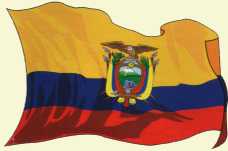
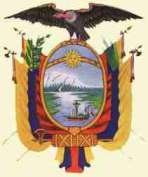 |
POLITICAL DIVISION OF ECUADOR With a unique contrast and privileges, the country is divided in provinces as following:
The Litoral or coast is covered with the water of the Pacific Ocean. The rainy or winter season start in December until May and the dry or summer season start in June until November. Starting in the extreme point of the mouth of Mataje River up to the extreme point in the south, the beaches or the Ecuadorian coast are wonderful. Litoral or Coast Region
ESMERALDAS
Tonsupa, located in the province of Esmeraldas is one of the beaches with the best Ecuadorian hotel structure in the north. It is placed in the highway that guide to Atacames.
MANABI
Bahía de Caraquez is the geographic accident most beautiful of Manabí. A beauty city by itself is ideal for the persons that want total isolation.
GUAYAS
Guayaquil, Pearl of the Pacific, is the principal port of the Ecuadorians. The Rotonda, it is where Martí and Bolivar outline the peace.
The Seminario park,
it is the place to appreciate the Monument of Simón Bolivar and the bottom of the Catedral.
LOS RIOS
The province of Los Ríos is the center of the coast region. It does not have coastline and it is known as the starting point area of the Chorrera culture and other antiques cultures.
EL ORO
El Oro, it is Known as the "The world capital of Banana" because of the extraordinary production of the fruit that it is required in all the markets of the world.
CARCHI
The Municipality burial ground in the city of Tulcán is unique in its kind for the reason that has sculptures carved in cypress that represents a variety of floras and fauna of the country.
IMBABURA
Otavalo.
Left::Left: In the plaza of the ponchos, you can walk between thousands of tapestries with different shapes, blue ponchos, thick sweaters of wool hand weave, gloves, caps, shawls, shigras, rope-soled shoes and other clothes. Also in the fair exist a lot of shops with handicrafts that attend all the week.
Right: The traditional "Coraza" that it is the protagonist of the parties around.
PICHINCHA
QUITO.- Between volcanoes painted over the mountain blue sky, it is extended Quito, the capital of Ecuador. The Ecuadorian line is located a few kilometers in the north so the sunbeams go down upright over this region.
COTOPAXI
The Cotopaxi volcano at 5.897 meters over the sea is the principal attractive of that province. The volcano has a conic shape almost perfect and it is one of the highest active volcanoes of the world.
TUNGURAHUA
The majesty of Tungurahua volcano with 5.020 meters over the sea takes a place in the landscape and the geography of this province.
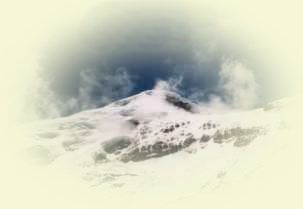
CHIMBORAZO
The Chimborazo volcano with 6.310 meters over the sea is the highest in Ecuador and with its measure starting in the center of the earth is the volcano with the main altitude of the world.
BOLIVAR The fair of Guaranda is distinguish with its folkloric staining, golden ponchos, black hats, horses and mules around the plaza 15 de Mayo that move the tourist to an imaginary world of other age.

CAÑAR The ruins of the Ingapirca castle and its incredible constructions are located in the middle of green fields and inlay in the highest mountains of the Andes. They are the principals attractive of this province. It is located at 53 km of the provincial capital Azogues.
AZUAY
The Chola Cuencana with her clothes of wide petticoat, folds in the waist and flashy embroiders is the characteristic personage of Cuenca.
LOJA "El Cisne" is the sanctuary inlay in the highest part of a cliff. This sanctuary promotes in its cathedral the worship of The Virgen of the Swan that is lovely called "la Churona".
SUCUMBIOS The ecological and tourist reserve of Cuyabeno, Coca and Cayambe are rich and fabulous because of the species biodiversity that are unique in the world.
NAPO Up: Francisco de Orellana used The Napo river, tributary of the Amazonas river, as a route for his expedition in order to discover that great river.
Down: The Sangay volcano. The counterfort of the volcano and its surrenders were declared as "National Park" by the government. In addition, the UNESCO recognized this place as Natural Patrimony of the Humanity in 1984.
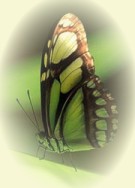
PASTAZA
In the full virgin jungle going over the Curacay river, it is located Pavacachi where you can see very close alligators, toucans, boas, the dangerous piraña fish and parrots.
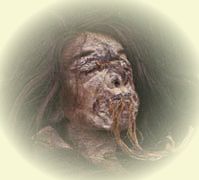
MORONA SANTIAGO
This province is characterized by the superstitions of the primitive men related with the "head hunters" and the well knows " tzantzas party". The Shuaras with the head of animals practiced these traditions, especially with monkeys.
ZAMORA CHINCHIPE
The yellow waters of the river Jumandi wash the fields of the village that has the same name. The river is fed by a lot of waterfalls of the mountains Imbana.
Insular Region
Also called "Archipielago de Galápagos" or "Archipielago de Colón". It comes from volcanic origins and has a fauna unique in the world. The beautiful archipelago made by 13 islands, 17 small barren islands and tens of rocks that emerge from a marine platform were transformed to National Park by the Ecuadorian government in 1959. Also, in 1978 the Unesco declared this place as "Natural Patrimony of the Humanity".
The most important attractive is the gigantic turtles called Galápagos, the marine and terrestrial lizards, penguins, albatross, piqueros, pelicans and other species.
We invite you to send important pictures of Ecuador in order to keep up this page,
to: fundaman@zona-andina.net


ADDRESS:
Dr. Harvey Rivadeneira Galeano
PRESIDENT - FUNDAMAN
PHONE NUMBER (593-2) 2411-151 - FAX: (593-2) 2256-658
P.O.BOX 17-17-279
e:mail: fundaman@zona-andina.net
e-mail: fundaman @uio.satnet.net
QUITO - ECUADOR